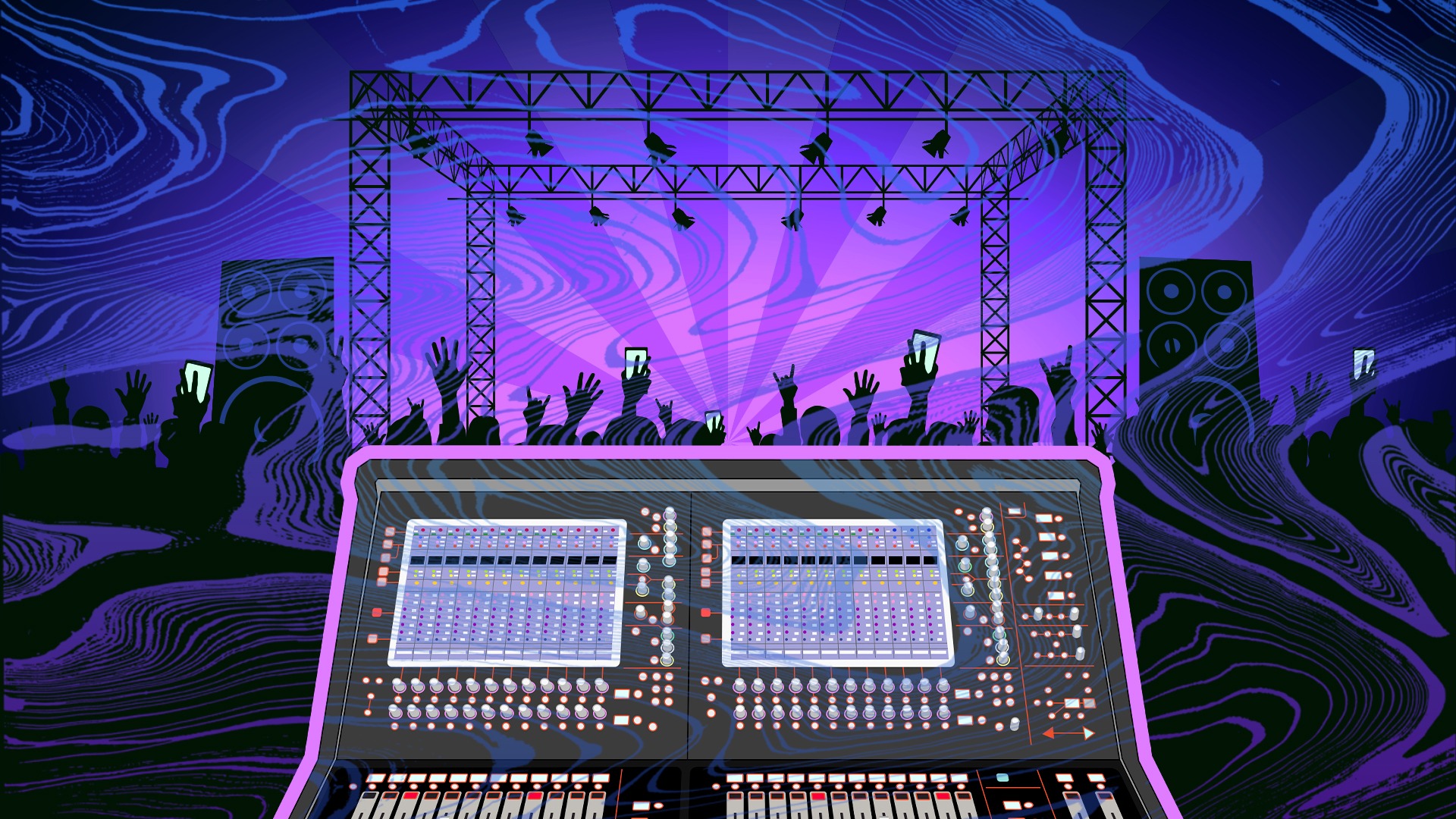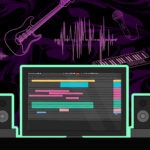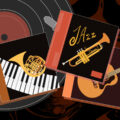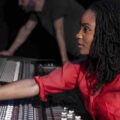Live sound is the most important part of a concert, film or live auditory experience. It’s also one of the highest-paid audio fields. Controlling sound in a live environment requires expertise, continuous practice, problem-solving skills, and ear training. The key to becoming an exceptional live sound engineer is education, experimentation, and experience. To help you get started on your live production journey, we’ve sourced and answered some of Quora’s most frequently asked introductory sound design questions.
How important is the sound mixer/audio engineer at concerts?
Audio engineers play just as big of a role, if not bigger, than the performers themselves.
Audio engineers are responsible for the sonic nuances you hear at a show – how each source sounds and how loud they are, what spatial effects you hear, etc. They bring balance and coherence to the sound of the performers.
Balancing all the elements of a live sound production
In addition to all that was mentioned above, sound engineers make sure the PA system is working, that all the frequencies are balanced, and issues of latency, phase, microphone bleed, amplifiers, feedback, and distortion are dealt with.
Anyone can put together a sound system and get sound out of it, but a professionally trained engineer can get a better sound, bring peace of mind to the performers, and ensure that the audience is having a great time.
Because no one likes to listen to performances where all you hear is feedback.
What is the best mixer for live sound?
There isn’t one best mixing console, but each mixer offers its own distinct workflow. Start by identifying what your needs are.
Identifying your needs:
- How many microphones (audio lines) will you be running?
- Will you be working with an installed sound system or portable?
- Will you have multiple performers throughout the night?
If the sound system is being used for 3-5 performances a night, a digital console will suit you better since you can soundcheck each band and save a preset with your mix. That way, when they get on stage, you can easily recall your mix and keep the show going. If you’re only dealing with one or two bands, an analog board might be easier for you.
Analog consoles:
- Simple navigation, easy to problem-solve
- Requires external processors like compressors and FX = $$$
- No recall function, unless done manually with pictures or templates
Digital Consoles:
- Slightly more complex navigation takes a little longer to problem-solve in order to navigate through multiple pages
- Built-in processors like compressors and FX for all channels at no additional cost
- Recall function available, which is good for mixing multiple bands
- Typically controllable with a phone or tablet
- May have a built-in recording function
Some good analog mixers include the Soundcraft GB series, Midas Venice and the Allen & Heath GL series. For digital consoles, take a look at the Soundcraft Si series, Allen & Heath QU series, Midas M32, and the classic Yamaha LS9 or 01V96ii. The Yamaha 01V96ii console is popular in smaller venues; the same goes for the Behringer X32.
There are more expensive digital consoles from the brands mentioned above, but bigger players like SSL also have live soundboards. However, these boards are typically used by the big league players who tour with major bands year-round.
Do you run live sound in mono or stereo?
It depends on the performers and venue
For the most part, engineers will tell you that they mix every channel in mono, with only a few panned left/right. The audience needs to be able to hear every performer, so you generally want to keep things mono. Otherwise, if you pan a source fully left, people on the right side won’t hear it as loudly, if at all.
If the venue can only hold around 100 people, where the distance between the left and right speaker is only 20 feet, you might get away with panning sources hard left or right. If the venue can have up to 300+ people and the PA is spread out 40+ feet, then you definitely won’t hear things if they were panned hard left/right.
One option is keeping everything mono except for drum overheads, toms, dual guitars, synths, backup vocals, and effects. However, sources like guitars, synth and backup vocals aren’t fully panned left/right; those should be pushed a little to the sides, so the middle isn’t too crowded.
You may be able to pan sources 20% or 50% and be able to hear it at either end of the space. Sometimes sources need to be panned in order to create an effect.
Try it for yourself, and walk around the venue and see what you like and what the limitations of a given room are.
How do live sound engineers use amplifiers?
Amplifiers are used for powering passive loudspeakers, whereas active loudspeakers have a built-in amplifier. In a passive loudspeaker system, the amplifiers would be connected after the crossover or equalizer, depending on the system.
A common signal flow would be:
1- L/R output of the mixer would go into a graphic equalizer
2- Output of the graphic equalizer would go into a crossover
3- Low-frequency output of the crossover would go into power amp 1
4- High-frequency output of the crossover would go into power amp 2
5- Amplifier output 1 would connect to a subwoofer
6- Amplifier output 2 would connect to a loudspeaker
Depending on if the system is a 3-way speaker array where you have subwoofers, mid-drivers, and tweeters in separate boxes, you would use a 3-way crossover with individual amplifiers for each driver. If you’re only using a full-range speaker, then you wouldn’t use a crossover in the signal chain.
Important:
You would not use an amplifier with an active loudspeaker.
In terms of operation, turn the audio equipment (i.e.: console and processors) on first, then power on the amplifiers or speakers last. When powering the system down, turn the amplifiers or speakers off first, then the audio system.
If you turn the amps on first, then power up the console, you’ll get a loud pop, which can damage a tweeter.
When connecting a passive sound system, you need to pay attention to how much wattage the amplifier can drive and what ohm rating it can handle. Be aware of what you’re plugging in, as you may blow an amplifier or speaker.
What are the practical differences between using analog vs digital mixers for live sound reinforcement?
When working on an analog or digital console, your workflow and cost are the biggest factors.
Analog consoles offer you the entire map at your fingertips. If you need to adjust the gain, EQ, or send of a source, the knob is right there for you to adjust.
Whereas with digital consoles, you need to be conscious of what you’re adjusting. You need to hit the select button of a channel you want to adjust every time. If you want to adjust another track, you need to select that track, etc.
Most importantly, digital consoles are built to be compact. With a digital console, you get multi-layers of pages from inputs/returns/sends/bus groups all in the same real estate. Any analog console would be 2-3x the size in width of the equivalent spec of a digital console.
In terms of cost, a digital console may seem more expensive at first, but you get dynamic processors and built-in effects for every channel, whereas, with most analog consoles, you’ll need to buy external processors like compressors and additional reverb units for every channel you want to process.
Analog consoles:
- Simple navigation, easy to problem-solve
- Requires external processors like compressors and FX = $$$
- No recall function, unless done manually with pictures or templates
- More reliable in terms of build quality
Digital Consoles:
- Slightly more complex navigation, takes a little longer to problem-solve in order to navigate through ten pages
- Built-in processors like compressors and FX for all channels at no additional cost
- Recall function available, good for mixing multiple bands
- Controllable with phone or tablet (great for adjusting monitors while on stage with an artist or for walking around the room while adjusting the mix)
- May have a built-in recording function
- Supports Dante and other network protocols for connecting multiple devices (stage boxes)
- Potentially faulty software (We’ve witnessed a faulty X32 board glitch during soundcheck and again during the show. We had to wait five minutes for it to boot back up)
- Longer boot-up time (it’s like turning on a computer, it takes a minute or two)
At music festivals, why does the sound mixing tend to be very low-quality?
We’re accustomed to listening to music on headphones, living room speakers, or at concert halls. All of these occur within an environment that has boundaries, whether that’s your head or walls. These walls contain the sound, shape it and amplify it to a certain degree.
Controlling sound in an unconfined environment
Since festivals generally occur in outdoor environments, there are no boundaries. Issues like wind, humidity, and temperature play a factor in how sound travels. This results in some frequencies travelling off into the air at different speeds, others being absorbed by human bodies, or simply being cancelled out. On top of this, you generally have thousands of people talking or screaming, which pollutes the sound of the system.
This is why at festivals, you will have a suspended system at the main stage with a front fill and delay towers at further distances to help amplify the sound across the area.
An easy solution would be to play the music louder, but there are regulations in place so that the FOH engineer doesn’t damage any eardrums. In most cases, cities have laws in place that limit music pollution to nearby neighbourhoods. Mixing in outdoor spaces is always a challenge for a mixing engineer.
Why is the sound mixing board at a live venue at a certain distance?
Creating an experience for the audience
Based on an equilateral triangle, the FOH mixing board is supposed to be at the centre point of the stage and 2/3 distance from both L/R speakers. This allows the engineer to hear both left and right speaker arrays and, as a result, get a better understanding of what the audience hears.
In smaller venues, this may not be possible. As a result, the board might end up either on the side of the stage or the back corner of the room. The engineer needs to be on their feet and walk around the room more often to hear what the audience hears.
You may also see two mixing boards, one in the middle of the room (FOH) and another on stage, which is the monitor board. The monitoring engineer is responsible for what the performers hear out of their in-ear systems or wedges. This is independent of the front-of-house mix and what the audience hears.
How do I get a job as a live sound engineer?
If you have knowledge of live sound, you need to go to every local bar, restaurant, venue, concert hall, and even touring company in your location and apply for a job.
Work your way up
You most likely will start as a runner (stage crew), but that’s what it takes to be part of the scene. Eventually, you may get a shot at mixing monitors or even FOH if the team is short one night.
Depending on the business, you might be brought on by the head engineer and trained as a backup. From there, you should try and be friendly with the bands that come in and offer your services. With time, they might remember you and reach out if they have an event and need an engineer.
If you’re just starting out and don’t know much about live engineering, it’s recommended to look at programs that teach audio production.
Working on music in a home studio doesn’t inform you of the complexities of a live sound installation. There are so many factors you need to know in order to mix a successful show.
Being part of a community definitely can help you get your foot in the door when you’re just starting off.
For more information about working with live sound, check out this article.
Are there programs that teach live sound engineering?
Yes, there are many great programs that teach the foundation of music production, post-production and live production. Live sound engineering involves knowing acoustics, routing, cabling, audio processors, consoles, speaker designs, interconnectivity, critical listening, and so much more. Not to mention safety measures you need to be aware of.
Our program at Recording Arts Canada‘s Sound & Music Program covers all the basics of Acoustics, Consoles, Signal Processing, and Live Sound production. Knowing the basics of live sound is critical to getting a job even as part of the stage crew, never mind being a FOH engineer.
Who are we?
Recording Arts Canada is a sound and music production college that offers an online or onsite program with campuses in downtown Montreal and Toronto. Our program combines essential theory, vital hands-on training, and career support, so you can start landing professional opportunities within a year. You can apply for our next cohort here.
Have a live sound engineering question? You can request we answer your question on Quora, and we’ll get back to you as soon as we can.
Illustration by Yihong Guo






















